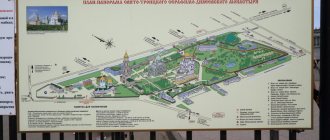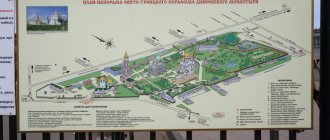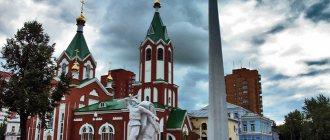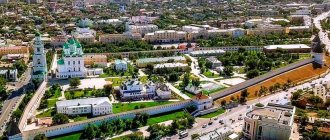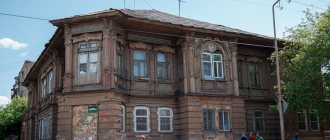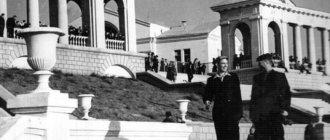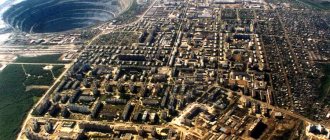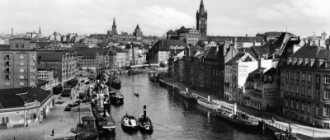Diveevo is a small village in the Nizhny Novgorod region, founded back in 1559. One of the common versions of its name says that the name of the village was given by the Nogai Murza Divey. He was the first owner of these places. Almost two centuries later, his descendants converted to Christianity. And Orthodox communities, churches, and shrines began to appear on the territory of Diveevo.
Today Diveevo is one of the Christian pilgrimage centers. The village is famous for the fact that here was the monastery of St. Seraphim of Sarov.
You can get to Diveevo by car or bus from Arzamas. There are no trains going here, and the nearest airport is near Nizhny Novgorod.
If you are passing through Arzamas, read what to see here first. And just 20 kilometers from Diveevo is the interesting city of Sarov (read why you should go there).
Read about other attractions around Diveevo in the guide to the Nizhny Novgorod region.
What to see in Diveevo in one day
Diveevo and its surroundings are famous for their sites of Russian Orthodox culture. These places are associated with the names of Seraphim of Sarov and other famous saints. Believers and pilgrims strive to come here. At the beginning of the article, attractions that can be visited in 1 day are highlighted.
Holy Trinity Seraphim-Diveevo Monastery
The main pearl of Diveevo is the active convent, a center of religious culture, with which the history of the village, its modern life and tourism potential are inextricably linked. Most of the attractions are located on the territory of the monastery or associated with it.
The monastery appeared here in the second half of the 18th century. The story began in the ancient capital of Rus' - the city of Kyiv. Here, in the Florovsky Monastery, the wealthy landowner Agafya Melgunova took monastic vows; she is known monastically as Mother Alexandra. She was destined to found a monastery in the northern lands, where she went after the appearance of the image of the Mother of God. The nun headed towards the Sarov desert.
Driving through the village of Diveevo, located not far from Sarov, Alexandra stopped for a while. The Mother of God appeared to her again in a dream, ordering her to establish a monastery in this place.
St. Seraphim, who had gone through the path of spiritual enlightenment in the nearby desert, would become the patron of the Diveyevo Monastery at the beginning of the 19th century. In 1842, his name will appear in the name; after the unification of two neighboring communities, the monastery will become Seraphim-Diveevskaya.
Today the monastery is active. Several temples have been preserved on its territory, each of which is a separate attraction.
Museum of the History of the Seraphim-Diveevo Monastery in the 20th Century
In Soviet times, the fate of the monastery was difficult. It was first registered as a labor artel, and then officially closed altogether. The nuns were persecuted, but remained committed to the faith.
In 1988, restoration of the monastery began, and in 2014 a museum was opened, the main theme of which was the history of the monastery in the 20th century. The forerunner of the museum was a small exhibition in the abbot's building. The materials on which the exhibition is based were collected over 15 years. The museum tells about the families of priests, about the fates of nuns and new martyrs.
In the halls, the interiors of living rooms are recreated, and personal belongings of the nuns are presented. The museum also illuminates eras of spiritual history; one of the rooms is dedicated to Seraphim of Sarov. Nowadays the museum actually plays the role of a local history center in the village.
Royal Skete and Seraphim Stones
The Seraphim-Diveevo Monastery has several monasteries located in the surrounding area. The most famous of them is called “Tsarsky”. It was founded by novices in the 1860s on lands granted by Emperor Alexander II.
The crowned family patronized the monastery, its members often came here. The monastery began with a wooden church and outbuildings. The attention of tourists is attracted by the “Virgin Alley”, planted by nuns. This was the local tradition - each newly arrived nun planted a tree. The abbess of the monastery from the moment of its foundation was Abbess Alexandra. The woman's life ended tragically; the Soviet authorities executed her in 1927. The grave is on the grounds.
The skete is located not far from the place where Saint Seraphim of Sarov prayed; it is interesting from a natural point of view. There are unliving witnesses who preserve the memory of his stay here. We are talking about boulders of different sizes - “Seraphim Stones”.
Don't miss: 35 attractions of the Nizhny Novgorod region
Attractions in the surrounding area
Museum of the Patriarchate (Arzamas)
Address: Arzamas, sq. Sobornaya, 1 A Phone: (83147) 9-43-10, 8-950-621-19-17 Opening hours: 10.00-18.00 daily, Mon - day off
This is the first and only museum telling about the life of Russian patriarchs. The history of the patriarchate in Rus' begins in 1589. The creators of the museum paid special attention to the patriarchate of the Soviet period.
The halls contain original items of the patriarchs and their replicas.
The museum is located in the magistrate's building, a historical building from the 18th century. This is the only ancient administrative building in the region and country that has been preserved in its original form and has not been rebuilt.
Florovsky monastery
Where is it located: 2 km from the Seraphim-Diveevsky Monastery
In 1997, it was decided to build a monastery in honor of the martyrs Florus and Laurus. The place for this was chosen near the Lomovka River.
Before the revolution, there was a monastery farm there, there was a laundry and a candle workshop.
The monastery initially consisted of a wooden church, then a stone one was erected. It is believed that the monastery was founded in memory of the time when Mother Alexandra lived in the Kiev Florovsky Monastery.
Holy Dormition Sarov Hermitage
Address: Sarov, Mira Ave., 40 Telephone: (83130) 3-09-28 Website: https://www.sarov-monastery.org/
At the beginning of the 18th century, a monastery was founded in the city of Sarov. But since the mid-17th century, this place has attracted hermit monks. They built their cells and lived in solitude.
The Sarov hermitage was founded by Hieromonk Isaac from the Vveedensky Monastery and the monk Philaret from the Sanaksarsky Monastery. Later, Prokhor Moshnin came here, who became Father Seraphim of Sarov.
In 1925, the monastery was closed, and all property was transferred to the Nizhny Novgorod NKVD. Almost before the start of the war there was a colony for prisoners.
Currently, the Sarov Hermitage includes several surviving or restored temples, churches, a bell tower and even a modern children's clinic.
Sanaksar Monastery
Address: Republic of Mordovia, Temnikov Telephone: (83445) 2-91-70
Along with the Sarov Desert, the Sanaksar Monastery was a center of spirituality. It was founded in 1659. The monastery got its name because of the small lake Sanaksar, next to which it was located.
The monastery existed as an independent brethren for about a hundred years. Then he went bankrupt and became part of the Holy Dormition Sarov Hermitage.
Nowadays there is a sawmill and candle production on the territory of the monastery.
The monastery itself was included in the Golden Ring route.
“Revealed” source of the Mother of God (Kremenka)
Address: pos. Kremenki
It is unknown when the source appeared. But he was noticed in 1670 on the eve of a fierce battle between the tsarist army and peasants from the army of S. Razin.
There is a belief that before the battle the water turned red and the face of the Virgin Mary appeared. She seemed to be mourning the dead.
It is also believed that Seraphim of Sarov can sometimes appear at this source.
Source in the name of the Holy Trinity (Avtodeevo)
Location: 3 km from the village. Avtodeevo
According to legend, an icon of the Holy Trinity appeared to a visiting woman. And after that, the water in the source began to have special properties.
Before the revolution, the Trinity holiday was celebrated here. Now this tradition has been resumed.
A bathhouse and a small chapel were built above the spring.
It is believed that those who have been trying to conceive a child for a long time can receive healing in the spring.
Temples and churches in Diveevo
Religious sites are an important component of the village's tourist treasures. All of them, as a rule, are located on the territory of the monastery, but there are also some that can be seen in the vicinity of Diveevo.
Trinity Cathedral
The main church of the monastery is the Trinity Cathedral. Its elegant appearance is the work of the architect A. Turmyshev. The master from Nizhny Novgorod combined classicist architectural features with elements of Old Russian and Byzantine styles.
The temple appeared to the world in the second half of the 19th century; it was built from 1848 to 1875. It functioned in its original form until 1927. In Soviet times it fell into disrepair and was plundered. After the collapse of the USSR in the 1990s, the shrine was restored.
Transfiguration Cathedral
The creation of the architect A. Antonov is a temple in the Old Russian style. It was erected exactly on the eve of the revolution. It was completed in 1916, but they did not have time to equip it. The church never became a place for services; its history almost ended before it began. In Soviet times, plans were hatched to undermine the building.
Fortunately, this did not happen - after restoration in the 1990s, the cathedral finally opened its doors at the beginning of the new century. The golden-domed, richly painted inside parish became a storage place for shrines that attracted pilgrims. Here are the relics of St. Martha and Blessed Pasha of Sarov.
Blagoveshchensky cathedral
A new century building, the appearance of which on the territory of the monastery is associated with its ancient history. It is believed that the Monk Seraphim himself bequeathed to build a temple on this site. The architecture of the cathedral, erected only in 2011, embodies the spirit of Moscow Baroque of the 18th century. The temple complex, as reviews and experts say, is very similar to the Assumption Church of the Kiev Pechersk Lavra.
Kazan Cathedral
The same name as the famous St. Petersburg cathedral, the temple in Diveevo is the “first sign” in the history of the local monastery. It was decided to build it on the very spot where the Mother of God appeared to Alexandra. The architectural style is Russian Baroque.
The cathedral was first built in 1779. The current Kazan Church is the result of restoration work that took place at the beginning of the new millennium. During the Soviet era, its building housed a dormitory for technical school students.
Church of the Assumption of the Virgin Mary in the village of Suvorovo
In the Diveyevo region there is the village of Suvorovo, which is also extremely remarkable from the point of view of Orthodox culture. Previously it was called Puzo. A famous native of this village, the holy fool Dunya Shishkova, was shot in 1919 along with three other nuns - Maria and two Darias. All of them are canonized as new martyrs.
The relics of the venerable martyrs of Puzov are kept in the Church of the Assumption of the Virgin Mary - this is the main attraction of the village of Suvorov. The church has been known since 1654, when these lands belonged to the boyar Grigory Pushkin. The stone temple was erected two centuries later, in the 1840s. During Soviet times it was ordered to be destroyed. It was restored in the 1990s.
Skete of the Holy Martyrs Florus and Laurus
The Holy Diveevsky Monastery includes a monastery, which appeared in 1997, four kilometers from the main monastery, on the banks of the Lomovka River. It was erected in the place where in imperial times there was a monastery farm with outbuildings.
The illumination took place in 2005 in honor of Florus and Laurel. The Holy Great Martyrs were not chosen by chance. Thus, they gave tribute to the “roots”, because the founder of the monastery came to these lands from the Kyiv Florovsky Monastery.
Holy Trinity Seraphim-Diveevo Monastery: photos and impressions of the visit
Village Diveevo
So, we arrived in Diveevo. The village itself, whose population is about 6.5 thousand people, seems to be all about pilgrims. Near the monastery there were traders, or rather, traders, selling what the pilgrim needed. Scarves and skirts are sold - in the Seraphim-Diveevo Monastery this is strict, women must wear a skirt/dress and cover their heads.
Problem with parking near the monastery
There is parking near the monastery. However, to our disappointment, there was a sign there that there was no room. Considering that I was driving a huge Mitsubishi L-200, this was somewhat disappointing. However, as it turned out, there were still places - our friends, who were driving the second car, parked calmly. It turned out that there were no places only for those who came overnight. But seeing the sign, it somehow didn’t occur to me to ask whether there were parking spaces or not. Having driven several circles around Diveevo and not finding any free ones (it was Saturday of Easter week, so there were a lot of people), I ended up parking the car with local residents near the house, right opposite the monastery. All the fun is 100 rubles. True, they helped us turn around in a bottleneck.
How to obtain permission to take photographs?
Next we had to get permission to take photographs. I was sent to a pilgrimage center. There was a line to the open window. The second window was open, but there was no one near it. However, there sat a stern nun who did not bother to answer whether permission could be obtained. As a result, after standing in line, I received permission to take photographs, paying either 30 or 50 rubles. Along the way, it turned out that I could do the same thing on the territory of the monastery, where the requirements are filled out.
Bell tower
Building on the territory of the monastery
Cathedral of the Life-Giving Trinity and Spaso-Preobrazhensky Cathedral in Diveevo
And here we are inside the monastery. In front of us are two huge cathedrals. The first, green, is the Cathedral of the Life-Giving Trinity , built between 1848 and 1875 by Ton’s student A.I. Rezanov, who also took part in the construction of the Cathedral of Christ the Savior in Moscow. In the Trinity Cathedral there is a shrine with the relics of Seraphim of Sarov.
A little further is a beautiful white temple - the Transfiguration Cathedral . They began to build it even before the revolution, but did not have time to consecrate it. During the Soviet years it housed a shooting range, then a garage. It was completed in the 90s and consecrated on September 3, 1998. We were not able to see the Transfiguration Cathedral from the inside - it was closed for cleaning
